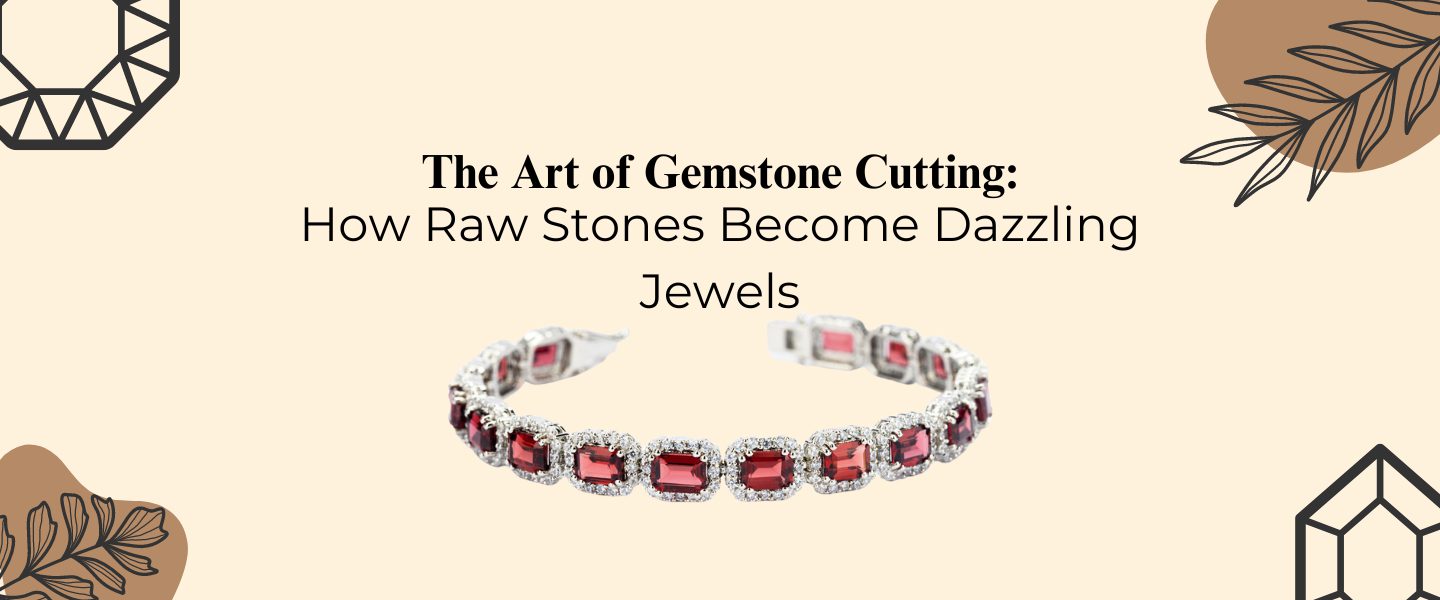Introduction
The journey of a gemstone from a raw, unpolished stone to a dazzling jewel is a fascinating blend of science, art, and craftsmanship. Gemstone cutting, also known as lapidary, is the intricate process that transforms rough, unrefined stones into the stunning, polished gems we admire in fine jewellery. This process requires precision, skill, and a deep understanding of the unique properties of each stone.
At Varnium by JMT, we value the artistry and craftsmanship that goes into every piece of jewellery. In this blog, we’ll explore the art of gemstone cutting, uncovering the techniques, history, and science behind the transformation of raw stones into the brilliant jewels that grace our collections.
The History of Gemstone Cutting: From Ancient Techniques to Modern Innovations
The art of gemstone cutting has a rich history that spans thousands of years. From the rudimentary techniques of ancient civilizations to the advanced technology used today, gemstone cutting has evolved significantly, but the goal has always remained the same: to enhance the natural beauty of the stone.
- Ancient Gem Cutting: The Origins of Lapidary The earliest gemstone cutting techniques date back to ancient civilizations, where rudimentary tools were used to shape and polish stones. In ancient Egypt, for example, craftsmen used sandstone, copper tools, and abrasives like quartz sand to carve gemstones into simple beads and amulets. These early lapidaries focused on enhancing the natural shape and colour of the stones, with little concern for symmetry or faceting.
- In India, the art of cutting and polishing gemstones flourished during the Mughal Empire. Indian artisans developed advanced techniques for cutting diamonds, sapphires, and other precious stones, creating intricate designs that were highly prized by royalty.
- While these ancient techniques were relatively simple, they laid the foundation for the development of more sophisticated cutting methods in later centuries.
- The Renaissance: The Birth of Faceted Gemstones The Renaissance period marked a significant advancement in gemstone cutting with the introduction of faceting. Faceting involves cutting flat surfaces, or “facets,” on a gemstone to enhance its brilliance and sparkle. This technique revolutionised the way gemstones were cut and is still the foundation of modern gemstone cutting.
- One of the most famous innovations of this period was the development of the brilliant cut, which maximises a diamond’s brilliance by optimising the angles of its facets. The brilliant cut became the standard for diamonds and remains one of the most popular cuts for gemstones today.
- During the Renaissance, European lapidaries also began experimenting with different cuts, such as the rose cut and the cushion cut, each designed to enhance the natural beauty of the stone. These cuts became popular in fine jewellery, and their influence can still be seen in modern designs.
- Modern Gemstone Cutting: Precision and Technology Today, gemstone cutting has evolved into a precise science, thanks to advancements in technology and the development of sophisticated tools. Modern lapidaries use computer-aided design (CAD) software, laser cutters, and precision saws to achieve unparalleled accuracy and consistency in their cuts.
- The modern lapidary’s toolkit includes diamond-tipped saws, grinders, and polishing wheels, allowing for precise shaping and finishing of gemstones. This technology has enabled the creation of new cuts, such as the princess cut and the radiant cut, which offer unique ways to showcase a gemstone’s brilliance.
- Despite these technological advancements, the art of gemstone cutting still requires a high level of skill and experience. Each gemstone is unique, and the lapidary must carefully consider the stone’s colour, clarity, and structure when determining the best cut.
The Process of Gemstone Cutting: Turning Raw Stones into Jewels
The process of transforming a rough gemstone into a polished jewel involves several stages, each requiring a combination of technical expertise and artistic vision. Let’s explore the key steps in gemstone cutting.
- 1. Evaluation and Planning Before a gemstone can be cut, it must be carefully evaluated by the lapidary. This involves examining the raw stone to determine its potential size, shape, and quality. The lapidary looks for any inclusions, fractures, or irregularities that could affect the final cut.
- The planning stage is crucial, as it determines the best way to maximise the stone’s beauty and value. The lapidary must consider factors such as the stone’s colour, clarity, and overall structure. For example, a stone with a deep, rich colour may benefit from a cut that emphasises its depth, while a stone with high clarity might be best showcased with a brilliant cut that maximises its sparkle.
- The lapidary may create a model of the stone using CAD software to visualise different cutting options before making a final decision.
- 2. Performing: Shaping the Stone Once the planning is complete, the lapidary begins the performing stage, where the rough stone is shaped into a form that closely resembles the final cut. This stage involves removing excess material from the stone using a diamond-tipped saw or a coarse grinding wheel.
- Performing is a delicate process that requires careful handling to avoid damaging the stone. The lapidary must work slowly and precisely, gradually shaping the stone into the desired form. The goal is to create a basic outline of the final cut while preserving as much of the stone’s weight and quality as possible.
- 3. Faceting: Creating the Facets Faceting is the most critical stage in gemstone cutting, as it involves creating the individual facets that will reflect light and give the stone its brilliance. The lapidary uses a faceting machine, which allows for precise control over the angle and placement of each facet.
- The first facets to be cut are usually the “table” (the large flat facet on the top of the stone) and the “pavilion” (the facets on the underside of the stone). These facets determine the overall shape and brilliance of the stone.
- The lapidary then cuts the crown facets (the facets on the top of the stone) and the girdle (the narrow band around the stone’s edge). The exact number and arrangement of facets depend on the desired cut, with some cuts requiring more facets than others.
- Each facet must be carefully polished to create a smooth, reflective surface. The polishing stage is crucial, as it enhances the stone’s brilliance and ensures that light is properly reflected through the facets.
- 4. Polishing: Achieving the Final Finish Polishing is the final stage of gemstone cutting, where the stone is given its final shine and lustre. The lapidary uses a series of progressively finer abrasives to smooth the surface of the stone, removing any remaining imperfections and enhancing its natural beauty.
- The polishing process requires a high level of precision and patience, as even the smallest flaw can affect the stone’s appearance. The lapidary must carefully polish each facet, ensuring that the angles are precise and the surfaces are flawless.
- Once the polishing is complete, the gemstone is ready to be set into jewellery, where it will be admired for its brilliance and beauty.
The Science Behind Gemstone Cutting: Understanding Light and Brilliance
Gemstone cutting is not just an art; it’s also a science. The way a gemstone is cut directly impacts its ability to reflect and refract light, which in turn affects its brilliance and sparkle. Understanding the science behind light and gemstones is key to appreciating the art of lapidary.
- Light Reflection and Refraction When light enters a gemstone, it can be either reflected off the surface or refracted through the stone. The way light interacts with the gemstone depends on the stone’s cut, clarity, and refractive index (a measure of how much light bends as it passes through the stone).
- The goal of gemstone cutting is to maximise the amount of light that is reflected back out of the stone, creating a dazzling sparkle. This is achieved by carefully controlling the angles of the facets, ensuring that light is properly directed through the stone and reflected back to the viewer.
- For example, the brilliant cut is designed to maximise a diamond’s brilliance by optimising the angles of the facets. This cut allows light to enter the stone, bounce off the pavilion facets, and exit through the crown facets, creating a stunning display of light and colour.
- Dispersion: Creating the “Fire” Dispersion, also known as “fire,” is the phenomenon that occurs when light is separated into its component colours as it passes through a gemstone. This creates the rainbow-like flashes of colour that can be seen in gemstones like diamonds and opals.
- The amount of dispersion in a gemstone depends on its refractive index and the precision of the cut. A well-cut gemstone will display a high level of fire, with vibrant flashes of colour that enhance its overall beauty.
- Understanding dispersion is essential for lapidaries, as it allows them to create cuts that maximise a gemstone’s fire and brilliance.
The Role of the Lapidary: The Artisan Behind the Stone
The lapidary is the skilled artisan responsible for transforming raw stones into dazzling jewels. This work requires not only technical expertise but also a deep appreciation for the unique qualities of each gemstone.
- Artistry and Creativity While gemstone cutting is a technical process, it also requires a high level of artistry and creativity. The lapidary must consider the natural beauty of the stone and how best to enhance its unique characteristics. This involves making artistic decisions about the shape, cut, and polish of the stone, ensuring that it reflects the vision of the final piece of jewellery.
- Each gemstone is different, and the lapidary must tailor their approach to suit the specific qualities of the stone. This creative process is what sets apart truly exceptional gemstone cutting, resulting in jewels that are not only beautiful but also unique.
- Experience and Skill Gemstone cutting is a skill that takes years to master. A lapidary must have a deep understanding of the properties of different gemstones, as well as the technical knowledge to use advanced tools and techniques. Experience is key, as it allows the lapidary to make informed decisions about how to cut and polish each stone.
- The best lapidaries are those who combine technical skill with a passion for gemstones, creating pieces that are both scientifically precise and artistically inspired.
Conclusion: The Art of Gemstone Cutting at Varnium by JMT
At Varnium by JMT, we believe in celebrating the artistry and craftsmanship that goes into every piece of jewellery. The transformation of raw stones into dazzling jewels is a process that requires skill, creativity, and a deep understanding of the science behind gemstones.
Our commitment to quality and craftsmanship means that every gemstone in our collection is cut with precision and care, ensuring that its natural beauty is fully realised. Whether you’re drawn to the brilliance of a well-cut diamond or the unique charm of a coloured gemstone, our jewellery is designed to showcase the art of gemstone cutting at its finest.
As you explore our collection, we invite you to appreciate the journey that each gemstone has taken—from a raw, unpolished stone to a stunning jewel that will be cherished for a lifetime. At Varnium by JMT, we celebrate the art of gemstone cutting, honouring the skilled artisans who bring these beautiful stones to life.


